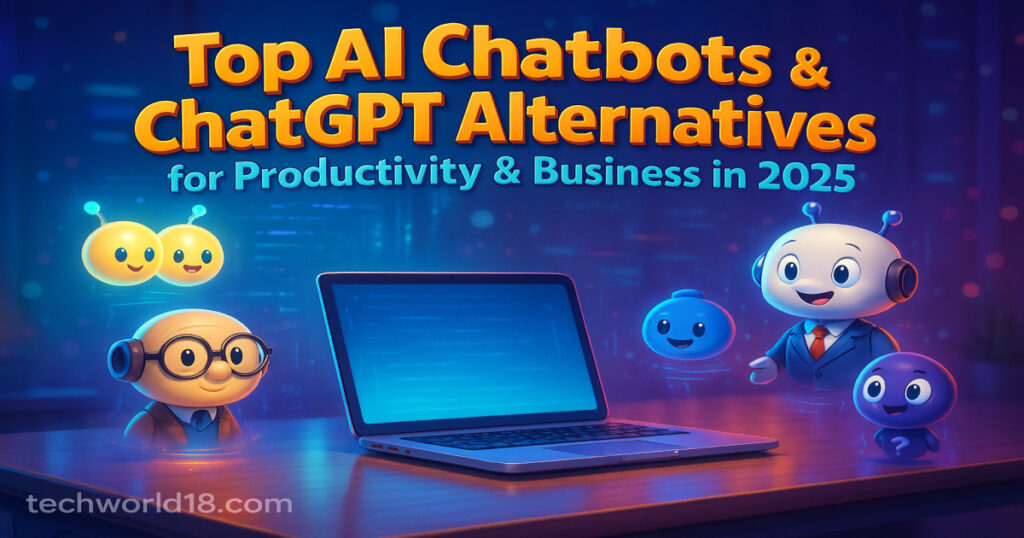# 25 Best ChatGPT Alternatives & AI Chatbots in 2025
Introduction: Why Look Beyond ChatGPT?
The AI chatbot landscape in 2025 is more dynamic than ever. While ChatGPT remains a leading name in conversational AI, there’s an entire ecosystem of powerful and specialized alternatives offering unique capabilities. Whether you’re a content creator, developer, business owner, or researcher, choosing the right AI assistant can significantly improve productivity, creativity, and efficiency.
Why consider alternatives?
ChatGPT excels in many areas, but you might need a solution that offers:
- Real-time data access
- Domain-specific expertise
- Privacy-first interactions
- Seamless integration with business tools
- Unique creative capabilities
From ethical AI assistants like Claude to research-focused platforms like Perplexity AI, the market now offers tools tailored to nearly every niche. This guide will help you explore the top 25 ChatGPT alternatives in 2025, their standout features, best use cases, and expert tips to help you choose the one that fits your exact needs.
Table of Contents
- Top 25 ChatGPT Alternatives in 2025: Quick Overview
- How to Choose the Right AI Chatbot for Your Use Case
- The 25 Best ChatGPT Alternatives – In-depth Reviews
- Feature Comparison Table
- Real-World Use Cases and Expert Insights
- FAQs: Choosing, Using, and Securing AI Chatbots in 2025
- Conclusion & Next Steps
Top 25 ChatGPT Alternatives in 2025: Quick Overview
Below is a snapshot of AI tools chosen for their innovation, scalability, user ratings, and capabilities. These chatbots are proven in real-world scenarios and are continuously evolving with new features.
| No | AI Tool | Best For |
| 1 | Claude by Anthropic | Ethical, professional writing |
| 2 | Google Gemini | Google integration, real-time data |
| 3 | Microsoft Copilot | Office & productivity |
| 4 | Perplexity AI | Research, citation-backed answers |
| 5 | DeepSeek AI | Data-driven insights |
| 6 | Jasper Chat | Marketing content creation |
| 7 | Chatsonic | Persona-based conversations |
| 8 | Replika | Personal AI companion |
| 9 | QuillBot AI Chat | Writing assistance, paraphrasing |
| 10 | Copy.ai | Blog & product copywriting |
| 11 | Grok (xAI) | Real-time, trending insights |
| 12 | Writesonic | Social media, emails, Ad copy |
| 13 | Elicit AI | Research summarization |
| 14 | YouChat AI | Summaries, code, conversation |
| 15 | HuggingChat | Custom open-source models |
| 16 | Meta AI (Llama) | Multimodal, open-source |
| 17 | Amazon CodeWhisperer | Developer support |
| 18 | GitHub Copilot | Coding productivity |
| 19 | Surfer AI | SEO-driven content |
| 20 | Character.AI | Roleplay, entertainment |
| 21 | Pi (Inflection AI) | Emotional support, conversation |
| 22 | Theb.ai Chat | Multilingual, image generation |
| 23 | OpenAI Playground | Custom model exploration |
| 24 | Semrush ContentShake AI | SEO copywriting |
| 25 | Undetectable.ai | Private, undetectable generation |
How to Choose the Right AI Chatbot for Your Use Case
When selecting the ideal AI chatbot, consider these key factors:
- Ease of Use: Look for intuitive interfaces, quick onboarding, and clear documentation.
- Accuracy: Ensure it delivers factual, up-to-date responses with minimal errors.
- Task Alignment: Match the tool to your main needs — content creation, coding, research, or personal assistance.
- Integrations: Check compatibility with tools like Google Workspace, Microsoft 365, CRMs, and APIs.
- Privacy & Security: Evaluate how the tool handles data storage, encryption, and compliance.
- Cost: Compare pricing plans, from freemium models to enterprise solutions.
- Top 25 Technology Trends for 2025 You Shouldn’t Miss
The 25 Best ChatGPT Alternatives – In-depth Reviews
1. Claude by Anthropic – Best for Ethical, Professional Use
Claude is built on a Constitutional AI framework, prioritizing safe, transparent, and ethical interactions. Its large context window makes it ideal for long, complex conversations — perfect for legal, academic, and enterprise applications.
Key strengths:
- Large context handling for detailed documents
- Strong emphasis on user safety
- Trusted by regulated sectors
Pricing: Free + Pro $20/month
Best for: Lawyers, analysts, enterprises
2. Google Gemini – Best for Real-Time Data & Google Integration
Gemini’s biggest advantage is seamless integration with Google Workspace tools like Docs, Sheets, and Gmail. It can fetch live data, automate workflows, and produce content directly inside your existing Google ecosystem.
Key strengths:
- Native Google app integration
- Multilingual capabilities
- Real-time knowledge updates
Pricing: Free, Business $20/user/month, Enterprise $30/user/month
Best for: Productivity, collaboration
3. Microsoft Copilot – Best for Office and Productivity Work
Microsoft Copilot integrates deeply into Word, Excel, Teams, and Outlook. It automates repetitive tasks, drafts professional emails, and summarizes meetings — making it a powerful business assistant.
Key strengths:
- MS Office ecosystem integration
- High document analysis accuracy
- Collaboration-friendly features
Pricing: Free basic, Pro $20/user/month
Best for: Businesses, project managers
4. Perplexity AI – Best for Research and Citation-Backed Answers
Perplexity AI stands out as one of the most reliable research-focused ChatGPT alternatives in 2025. Designed to provide accurate, citation-backed answers, it’s a go-to platform for academics, journalists, analysts, and professionals who demand credible and verifiable information.
Unlike many AI chatbots that deliver confident-sounding but sometimes inaccurate responses, Perplexity integrates advanced web search capabilities with scholarly databases and real-time sources. Every claim is paired with citations you can verify instantly—making it an invaluable tool for fact-checking, in-depth research, and professional reporting.
Expanded Features:
- Deep Research Mode: Generates comprehensive multi-page reports with all references listed in standard citation formats (APA, MLA, Chicago).
- Live Web Integration: Pulls information directly from the latest credible web sources.
- Source Transparency: Displays links and snippets for every claim, so users can verify the context.
- Custom Filters: Allows filtering results by date, domain type (e.g., .edu, .gov), or publication credibility.
- Multi-Device Sync: Research projects sync across desktop, mobile, and browser extensions.
Best For:
- University students compiling research papers.
- Journalists conducting investigative reporting.
- Compliance officers gathering verified industry updates.
- Knowledge workers needing quick, credible summaries.
Use Case Example: A financial analyst uses Perplexity to compile a competitive market report for a quarterly board meeting. The tool not only gathers the latest market data but also provides properly cited references, enabling the analyst to present trusted insights with confidence.
Pros:
- High reliability and trustworthiness.
- Easy access to source material.
- Ideal for academic and professional standards.
Cons:
- May be slower than conversational AI focused solely on speed.
- Some features locked to Pro version.
Pricing: Free basic plan; Pro plan at $20/month includes unlimited deep research queries, more customization, and priority server access.
5. DeepSeek AI – Best for Data-Driven Insights & Business Analytics
DeepSeek AI specializes in turning complex datasets into actionable insights. It’s designed for enterprises, data analysts, and decision-makers who need to extract trends, patterns, and forecasts from large amounts of structured or unstructured data.
Expanded Features:
- Predictive Analytics: Uses machine learning to forecast outcomes based on historical data.
- Automated Reporting: Generates business intelligence reports without manual effort.
- Unstructured Data Parsing: Processes text, images, and logs to identify trends.
- Integration with BI Tools: Compatible with Tableau, Power BI, and Looker.
- Custom AI Models: Build and train models tailored to specific industries.
Best For:
- Enterprise analytics teams.
- Market research firms.
- Operations managers seeking efficiency insights.
- Financial forecasting departments.
Use Case Example: A retail chain uses DeepSeek to predict seasonal demand changes, optimizing inventory across hundreds of locations, resulting in reduced costs and higher sales.
Pros:
- Powerful predictive capabilities.
- Handles large-scale data efficiently.
- Flexible integrations with existing BI workflows.
Cons:
- Requires some technical expertise.
- Best suited for mid-to-large-scale organizations.
Pricing: Custom quotes based on usage and features.
6. Jasper Chat – Best for Marketing & Content Creation
Jasper Chat is tailored for marketers, SEO specialists, and creative teams looking to produce high-quality content at scale. With over 20 language options and memory retention across sessions, Jasper delivers context-aware and brand-consistent messaging.
Expanded Features:
- SEO-Optimized Templates: Built-in tools for keyword integration and SERP-friendly content.
- Brand Voice Memory: Remembers tone, style, and past preferences.
- Content Collaboration: Multiple team members can work on projects simultaneously.
- Multi-Channel Copywriting: Generates text for blogs, ads, emails, and social media.
- Real-Time Data Fetching: Accesses live web content for up-to-date information.
Best For:
- Digital marketing agencies.
- E-commerce brands.
- Social media managers.
- Content strategists.
Use Case Example: A startup uses Jasper to create an entire product launch campaign—blog posts, ad copy, email sequences—within a week, saving thousands in outsourced work.
Pros:
- Strong SEO capabilities.
- Consistent brand voice across platforms.
- Supports rapid content production.
Cons:
- Premium pricing for advanced features.
- Requires fine-tuning prompts for best results.
Pricing: Starter $40/month, Boss Mode $82/month, custom enterprise plans available.
7. Chatsonic – Best for Persona-Based Creative AI
Chatsonic differentiates itself with persona-driven conversations. You can chat with the AI as a marketer, fitness coach, or even a travel guide, tailoring the tone and expertise to your scenario.
Expanded Features:
- Persona Library: Dozens of built-in personas for niche conversations.
- Voice & Image Integration: Speak to Chatsonic or receive AI-generated visuals.
- Custom Personas: Create and save your own personality templates.
- Content Templates: Pre-set formats for blogs, ads, and product descriptions.
- API Access: Integrate persona-based responses into apps or websites.
Best For:
- Creative agencies.
- Customer support teams needing role-based responses.
- Educators and coaches.
Use Case Example: A travel agency uses Chatsonic’s tour guide persona to answer customer inquiries with local tips, photos, and itinerary suggestions in real-time.
Pros:
- Highly customizable interactions.
- Multimedia capabilities.
- Ideal for creative and engagement-heavy roles.
Cons:
- Free plan has limited word count.
- Persona accuracy depends on input quality.
Pricing: Free up to 10,000 words/month; paid plans start at $12.67/month.
8. Replika – Best for Personal AI Companionship
Replika is designed for emotional support, companionship, and personal growth. Unlike productivity-focused AI, it focuses on human-like conversation to help users feel heard and understood.
Expanded Features:
- Voice and Video Calls: Interact naturally using your voice or camera.
- Customizable Personality: Adjust traits, conversation style, and even the AI’s avatar.
- Emotional Tracking: Logs moods and helps identify emotional patterns over time.
- Activity Suggestions: Encourages journaling, mindfulness, or hobbies.
Best For:
- Individuals seeking emotional support.
- People practicing social skills.
- Those looking for a non-judgmental conversation partner.
Use Case Example: A user going through a stressful life transition uses Replika for daily check-ins and guided meditations, improving their emotional resilience.
Pros:
- Highly personalized interactions.
- Encourages self-reflection.
- Offers both text and multimedia engagement.
Cons:
- Limited practical or factual capabilities.
- Premium pricing for full features.
Pricing: Pro $19.99/month, Lifetime $299.99.
9. QuillBot AI Chat – Best for Writing Assistance & Paraphrasing
QuillBot AI Chat specializes in helping writers refine and restructure their text while maintaining clarity and style.
Expanded Features:
- Advanced Paraphrasing: Multiple modes (fluency, creative, formal) to match tone.
- Grammar and Style Suggestions: Corrects errors and improves readability.
- Synonym Control: Adjust vocabulary complexity.
- Citation Generation: Formats references in multiple academic styles.
Best For:
- Students writing essays.
- Professionals drafting reports.
- Content creators optimizing their copy.
Use Case Example: A freelance writer uses QuillBot to rephrase product descriptions for multiple marketplaces, ensuring each listing is unique and SEO-friendly.
Pros:
- Easy to use.
- Effective for academic and professional writing.
- Affordable premium option.
Cons:
- Limited to text-based tasks.
- Requires manual review for nuanced content.
Pricing: Free basic plan, Premium from $4.17/month.
10. Copy.ai – Best for Blog and Product Copy Generation
Copy.ai streamlines marketing content creation by offering AI-powered templates for blogs, social media captions, product descriptions, and more.
Expanded Features:
- Diverse Templates: 90+ formats for various content needs.
- Collaboration Features: Invite team members to edit projects.
- Brand Voice Settings: Maintain consistent messaging.
- Idea Generation Tools: Helps brainstorm headlines, hooks, and campaign angles.
Best For:
- E-commerce businesses.
- Marketing teams.
- Content creators managing multiple channels.
Use Case Example: An online store uses Copy.ai to quickly create seasonal product descriptions and promotional emails, freeing the marketing team to focus on strategy.
Pros:
- Reduces content creation time.
- Simple, intuitive interface.
- Wide range of formats.
Cons:
- Occasional generic outputs.
- Premium tier required for advanced tools.
Pricing: Free up to 2,000 words/month, Pro $49/month.
11. Grok (xAI) – Best for Trending, Real-Time Insights
Developed by Elon Musk’s xAI, Grok focuses on delivering real-time, contextual insights. Designed for users who need up-to-the-minute information on trending topics, current events, or rapidly changing data, Grok blends conversational AI capabilities with a strong emphasis on live data access.
Expanded Features:
- Current Events Awareness: Continuously updated knowledge base tied to news and social platforms.
- Contextual Summaries: Digest complex events into concise overviews.
- Interactive Data Queries: Pulls data from APIs for real-time metrics.
- Trend Analysis Tools: Identifies emerging topics across industries.
Best For:
- Journalists and news analysts.
- Social media managers tracking trending topics.
- Public relations teams managing brand reputation.
Use Case Example: A PR agency uses Grok to monitor brand mentions across social platforms in real-time, adjusting their communication strategy as events unfold.
Pros:
- Rapid access to trending data.
- Excellent for time-sensitive industries.
- Strong contextual summarization.
Cons:
- Heavily dependent on internet access.
- Not ideal for offline research.
Pricing: Varies; often free for public chats.
12. Writesonic – Best for Fast Content & Ads
Writesonic excels in producing marketing content quickly. Built for speed and scalability, it’s a strong tool for businesses that need ad copy, blog content, and social media posts in minutes.
Expanded Features:
- Industry-Specific Templates: Prebuilt frameworks for ads, emails, and product descriptions.
- SEO Mode: Generates keyword-rich content tailored for rankings.
- Bulk Content Creation: Create multiple pieces at once.
- Integrations: Works with WordPress, Shopify, and Google Docs.
Best For:
- Digital marketing teams.
- Small businesses needing quick ad copy.
- Social media content managers.
Use Case Example: An e-commerce brand uses Writesonic to create 50 unique product descriptions in under an hour, optimizing them for SEO before launch.
Pros:
- Extremely fast turnaround.
- Flexible output options.
- Affordable entry plans.
Cons:
- May require editing for nuanced tone.
- Templates can feel formulaic.
Pricing: Free limited plan; paid plans from $12/month.
13. Elicit AI – Best for Scholarly Research Summarization
Elicit AI is built for academics and researchers who need efficient literature reviews and paper summarization. Using AI to parse scholarly articles, it helps condense complex research into actionable insights.
Expanded Features:
- Paper Summarization: Pulls abstracts and key findings from large datasets of academic papers.
- Research Q&A: Answers questions using verified academic sources.
- Automated Literature Review: Compiles and organizes references around a given topic.
- Filter by Credibility: Focus on peer-reviewed journals or specific publication dates.
Best For:
- University researchers.
- Students writing dissertations.
- Policy analysts.
Use Case Example: A graduate student uses Elicit AI to find, summarize, and compare 20 papers on climate policy, cutting their literature review time in half.
Pros:
- Saves significant research time.
- High academic relevance.
- Intuitive filtering tools.
Cons:
- Limited to academic/research content.
- Dependent on access to databases.
Pricing: Free to use; premium features under development.
14. YouChat AI – Best for Code, Summaries, and General Information
YouChat AI is a versatile AI assistant designed for users who need quick, reliable answers across multiple domains—coding, general knowledge, and content summarization. Unlike many AI chatbots, YouChat offers transparent sourcing and integrates real-time search capabilities to enhance accuracy.
Expanded Features:
- Live Web Search: Provides up-to-date responses with sources.
- Code Assistance: Debugs, explains, and generates code snippets in various programming languages.
- Summary Mode: Condenses articles, reports, and documents.
- Multilingual Support: Answers and summaries available in multiple languages.
- Contextual Awareness: Remembers recent conversation context for continuity.
Best For:
- Developers looking for quick code help.
- Students summarizing study materials.
- Professionals who need concise information fast.
Use Case Example: A developer uses YouChat to debug a Python script and simultaneously get documentation links, saving time switching between multiple tools.
Pros:
- Flexible for multiple use cases.
- Transparent citations.
- Easy-to-use interface.
Cons:
- May not handle highly complex programming tasks.
- Dependent on web access for best results.
Pricing: Free to use.
15. HuggingChat – Best for Open-Source and Custom AI Conversations
HuggingChat is powered by HuggingFace’s open-source models, making it the perfect choice for developers, researchers, and privacy-conscious users who want full control over their AI assistant.
Expanded Features:
- Open-Source Flexibility: Modify models and training data to fit your needs.
- Community Support: Benefit from a large, active developer community.
- Custom Deployment: Host your AI on private servers for maximum data control.
- Integration Ready: Connect with APIs, apps, and enterprise systems.
Best For:
- Developers building custom AI applications.
- Organizations prioritizing data privacy.
- Researchers experimenting with AI models.
Use Case Example: A startup integrates HuggingChat into its internal HR system to create a private AI assistant that can answer employee questions without sending data to third-party servers.
Pros:
- Fully customizable.
- Privacy-friendly.
- Supported by a vibrant open-source community.
Cons:
- Requires technical expertise.
- Less polished interface compared to commercial tools.
Pricing: Free.
16. Meta AI (Llama) – Best for Multimodal and Open-Source Development
Meta AI’s LLaMA models are among the most powerful open-source AI offerings in 2025, designed for multimodal applications involving text, image, and even code inputs and outputs.
Expanded Features:
- Multimodal Capabilities: Handles text, images, and code.
- Large Model Variants: Scalable models for research or production.
- Open-Source Licensing: Freedom to customize and deploy without restrictions.
- Strong Research Backing: Developed by Meta’s AI research team.
Best For:
- Developers building multimodal applications.
- Academic researchers working on AI.
- Companies wanting an open-source alternative to proprietary AI.
Use Case Example: An edtech platform uses LLaMA to develop an interactive learning assistant that can process both student essays and uploaded diagrams to provide personalized feedback.
Pros:
- Multimodal support.
- Highly adaptable for different industries.
- Backed by strong research.
Cons:
- Requires robust infrastructure for large models.
- Setup and fine-tuning can be complex.
Pricing: Free and open-source.
17. Amazon CodeWhisperer – Best for AWS Developers
Amazon CodeWhisperer is a powerful AI coding companion designed specifically for developers working within the AWS ecosystem. It offers real-time code suggestions, security scanning, and deep integration with AWS services, helping engineers build and deploy faster.
Expanded Features:
- AWS Service Integration: Direct support for Lambda, S3, DynamoDB, and other AWS services.
- Real-Time Code Suggestions: Predictive typing for multiple programming languages.
- Security Scans: Identifies vulnerabilities in your code as you write.
- Custom Code Recommendations: Tailors suggestions based on project context.
- IDE Integration: Works seamlessly with popular IDEs like VS Code, JetBrains, and AWS Cloud9.
Best For:
- Cloud engineers.
- AWS-certified developers.
- Startups building AWS-first applications.
Use Case Example: A fintech startup uses CodeWhisperer to build a secure payment processing microservice in AWS Lambda, reducing development time by 30%.
Pros:
- Optimized for AWS.
- Improves development speed.
- Built-in security features.
Cons:
- Limited utility outside AWS.
- Requires AWS account for full benefits.
Pricing: Free for individuals; $19/month for professional teams.
18. GitHub Copilot – Best for Coding Productivity
GitHub Copilot, powered by OpenAI models, is a general-purpose coding assistant that integrates directly into your IDE. It’s designed to speed up software development by providing intelligent code completions, explanations, and even test generation.
Expanded Features:
- Code Autocompletion: Suggests lines or entire functions.
- Code Explanation Mode: Breaks down complex code for better understanding.
- Test Generation: Automatically creates unit tests for your functions.
- Multi-Language Support: Works with Python, JavaScript, Java, Go, and more.
- Pair Programming Simulation: Acts like a collaborative partner, suggesting improvements.
Best For:
- Full-stack developers.
- Students learning to code.
- Teams seeking faster iteration.
Use Case Example: A SaaS company uses Copilot to rapidly prototype new features, allowing their development team to focus on higher-level architecture.
Pros:
- Works with most major programming languages.
- Significantly speeds up coding.
- Great learning tool.
Cons:
- Can produce inaccurate code if prompts are unclear.
- Requires code review for production.
Pricing: $10/month for individuals, $19/month for businesses.
19. Surfer AI – Best for SEO-Driven Content Creation
Surfer AI combines SEO expertise with AI writing capabilities to help marketers and bloggers produce content optimized for Google rankings. It’s a favorite for those who want content that not only reads well but also ranks.
Expanded Features:
- SERP Analysis: Examines top-ranking pages to guide content structure.
- Keyword Optimization: Suggests keywords, headings, and semantic terms.
- Content Score: Rates your draft’s SEO quality in real-time.
- Content Brief Generator: Creates detailed outlines for writers.
- Integrations: Works with Google Docs and WordPress.
Best For:
- SEO agencies.
- Content marketers.
- Bloggers aiming for organic growth.
Use Case Example: A marketing team uses Surfer AI to create a series of blog posts targeting high-intent keywords, increasing organic traffic by 40% in three months.
Pros:
- Strong SEO focus.
- Data-driven recommendations.
- Integrates into common workflows.
Cons:
- Learning curve for SEO beginners.
- Requires subscription for ongoing use.
Pricing: Custom pricing based on usage and features.
20. Character.AI – Best for Roleplay and Entertainment
Character.AI offers a creative twist to AI interactions, letting you roleplay with fictional, historical, or custom characters. Whether you want to chat with Einstein, a fantasy hero, or a self-created persona, this platform makes it possible.
Expanded Features:
- Roleplay Library: Choose from thousands of prebuilt character personas.
- Custom Character Builder: Design your own personalities with specific backstories.
- Voice Input Support: Engage in conversations verbally.
- Interactive Storytelling: Collaborate with AI in narrative creation.
Best For:
- Gamers and storytellers.
- Educators designing interactive learning.
- Writers seeking inspiration.
Use Case Example: A history teacher uses Character.AI to create historical figure simulations for an immersive classroom experience, allowing students to “interview” famous leaders.
Pros:
- Highly creative and engaging.
- Large variety of personas.
- Easy to customize.
Cons:
- Not optimized for factual accuracy.
- Can produce unpredictable responses.
Pricing: Free.
21. Pi (Inflection AI) – Best for Emotional Support
Pi focuses on emotionally intelligent conversations, offering empathy, active listening, and thoughtful responses. It’s designed to help users with stress, decision-making, or simply as a friendly companion.
Expanded Features:
- Conversational Empathy: Understands tone and emotional cues.
- Wellness Tools: Provides mindfulness exercises and reflective prompts.
- Goal Tracking: Assists with setting and tracking personal goals.
- Mobile-First Design: Optimized for quick, on-the-go chats.
Best For:
- People seeking non-judgmental conversation.
- Individuals working on personal growth.
- Users needing emotional check-ins.
Use Case Example: A remote worker uses Pi for daily motivation and stress management tips, helping them stay balanced during high-pressure projects.
Pros:
- Warm and supportive interaction style.
- Encourages self-improvement.
- Completely free.
Cons:
- Limited technical or factual capabilities.
- May not replace professional counseling.
Pricing: Free.
22. Theb.ai Chat – Best for Multilingual and Image Generation
Theb.ai Chat is a cost-effective AI chatbot that excels at multilingual support and image generation. It’s a great fit for global teams and creatives needing quick visual content.
Expanded Features:
- 170+ Language Support: Communicate in nearly any language.
- Text-to-Image Creation: Generate AI visuals from descriptions.
- Low-Cost Plans: Affordable for individuals and small teams.
- Customizable Outputs: Control image style, tone, and resolution.
Best For:
- International customer service teams.
- Content creators producing visuals.
- Businesses with global operations.
Use Case Example: A global NGO uses Theb.ai Chat to translate communications into multiple languages and generate campaign visuals, streamlining outreach.
Pros:
- Affordable.
- Combines text and image generation.
- Wide language coverage.
Cons:
- Image generation quality can vary.
- Limited integrations.
Pricing: $0.99/month (ads-free), $0.003 per 1k tokens for standard use.
23. OpenAI Playground – Best for Custom Model Exploration
OpenAI Playground allows developers, researchers, and AI enthusiasts to experiment with different OpenAI models in a highly customizable environment. It’s ideal for those who want to test prompts, fine-tune models, and understand AI behavior.
Expanded Features:
- Custom Prompt Testing: Quickly iterate prompts for optimal results.
- Model Selection: Access multiple GPT versions and fine-tuning options.
- Temperature and Token Control: Adjust creativity and output length.
- Export Capabilities: Save and share prompt configurations.
Best For:
- Developers prototyping AI features.
- Researchers studying AI behavior.
- Educators teaching AI concepts.
Use Case Example: A developer uses Playground to fine-tune an AI model for customer support responses, optimizing tone and accuracy before deploying in production.
Pros:
- Flexible experimentation.
- Access to multiple models.
- Great learning tool.
Cons:
- Requires some technical knowledge.
- Usage costs can add up with high-volume testing.
Pricing: Pay-as-you-go.
24. Semrush ContentShake AI – Best for SEO Copywriting
Semrush ContentShake AI merges AI writing capabilities with Semrush’s SEO expertise, making it an ideal tool for high-competition content marketing.
Expanded Features:
- Keyword Research Integration: Pulls real-time keyword data from Semrush.
- SEO-Optimized Drafts: Generates copy designed to rank.
- Competitor Analysis: Shows gaps and opportunities in your niche.
- Content Performance Tracking: Monitors SERP rankings post-publication.
Best For:
- SEO agencies.
- Marketing teams.
- Businesses competing in saturated markets.
Use Case Example: A digital agency uses ContentShake AI to create optimized blog posts that outrank competitors within weeks of publishing.
Pros:
- Combines AI and proven SEO tools.
- Comprehensive optimization process.
- Ideal for competitive niches.
Cons:
- Requires Semrush subscription.
- Best suited for SEO professionals.
Pricing: Custom plans.
25. Undetectable.ai – Best for Privacy and Secure Content Generation
Undetectable.ai specializes in producing text that bypasses AI detection tools while maintaining human-like quality. It’s a preferred choice for sensitive industries where confidentiality and privacy are paramount.
Expanded Features:
- Detection Evasion: Generates content that passes AI content checkers.
- Privacy Focus: No data is stored after generation.
- Custom Output Styles: Adjust tone, formality, and vocabulary.
- Integration Options: API access for bulk content needs.
Best For:
- Legal and compliance teams.
- Journalists handling confidential sources.
- Writers needing AI-safe content.
Use Case Example: A law firm uses Undetectable.ai to draft confidential briefs without triggering AI detection software used in sensitive legal environments.
Pros:
- Privacy-first approach.
- High customization.
- Reliable detection evasion.
Cons:
- May not be necessary for all use cases.
- Premium pricing for high volumes.
Pricing: Custom, based on volume.
Feature Comparison Table: Top ChatGPT Alternatives for 2025
| AI Tool | Pricing | Unique Features | Best For | Overall Rating |
| Character.AI | Free | Roleplay library, custom persona builder, voice support, interactive storytelling | Gamers, educators, storytellers | 4.6/5 |
| Pi (Inflection AI) | Free | Conversational empathy, wellness tools, goal tracking, mobile-first | Emotional support, personal growth | 4.7/5 |
| Theb.ai Chat | $0.99/mo+ | 170+ languages, text-to-image generation, customizable output | Global teams, visual creators | 4.3/5 |
| OpenAI Playground | Pay-as-you-go | Custom prompt testing, multiple model access, parameter control | Developers, researchers | 4.7/5 |
| Semrush ContentShake AI | Custom | Keyword integration, SEO-optimized drafts, competitor analysis | SEO agencies, marketing teams | 4.6/5 |
| Undetectable.ai | Custom | Detection evasion, privacy-first, custom output styles | Legal, compliance, confidential writing | 4.5/5 |
Real-World Use Cases and Expert Insights
- Character.AI in Education: Teachers create interactive roleplay scenarios where students interview historical figures, improving engagement and retention.
- Pi for Mental Wellness: Remote workers use Pi for daily motivational check-ins and mindfulness exercises, improving emotional resilience.
- Theb.ai Chat in Global Business: Multinational corporations deploy Theb.ai to translate live customer support chats while generating marketing visuals for global campaigns.
- OpenAI Playground in Development: Developers prototype customer service bots and fine-tune tone before integrating AI into production environments.
- Semrush ContentShake AI for Competitive SEO: Digital marketers use ContentShake AI to target high-value keywords, outrank competitors, and track performance with integrated analytics.
- Undetectable.ai for Legal Privacy: Law firms use the tool to prepare confidential documents that pass AI detection, ensuring client confidentiality.
FAQs: Choosing, Using, and Securing AI Chatbots in 2025
Q1: Which AI chatbot is best for creativity and storytelling?
A: Character.AI is ideal for storytelling, roleplay, and interactive learning scenarios.
Q2: What’s the most privacy-focused AI tool?
A: Undetectable.ai leads in privacy with no data retention and custom, detection-proof outputs.
Q3: Which chatbot is best for multilingual work?
A: Theb.ai Chat supports over 170 languages and offers text-to-image generation for global marketing.
Q4: Can I test and customize AI models before deployment?
A: Yes. OpenAI Playground allows full model experimentation, fine-tuning, and integration testing.
Q5: Which tool combines SEO data with AI content generation?
A: Semrush ContentShake AI blends real-time keyword analysis with AI writing to create optimized, high-ranking content.
Conclusion & Next Steps
The final six tools in our 25 best ChatGPT alternatives list prove that AI chatbots are not just for conversation—they’re shaping industries, enhancing creativity, and improving productivity worldwide. From privacy-first content creation to emotionally intelligent support, there’s a specialized AI for every need.
Action Steps:
- Match your primary need—creativity, privacy, SEO, multilingual support—to the right tool.
- Test your top choices using free plans or trials.
- Integrate the chosen AI into your workflow and measure results.
- Top 15 Free AI SEO Tools for 2025: Boost Rankings & Save Money
By leveraging the right AI solution, you can work smarter, create better, and maintain a competitive edge in 2025.








5to4ij